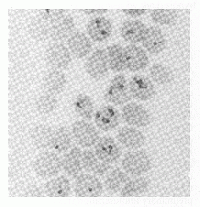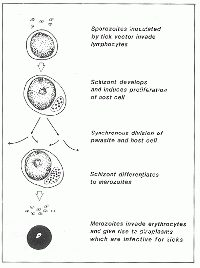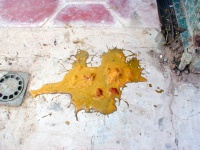Difference between revisions of "Theileriosis - Cattle"
| (19 intermediate revisions by 2 users not shown) | |||
| Line 1: | Line 1: | ||
| − | Also Known As | + | {{OpenPagesTop}} |
| + | Also Known As: '''''Bovine Theileriosis — [[Theileria]] — [[East Coast Fever]] — Egyptian Fever — Tropical Theileriosis — Mediterranean Coast Fever''''' | ||
| + | |||
| + | Caused By: [[Theileria|'''''Theileria parva''''' — '''''Theileria annulata''''']] | ||
| − | |||
| − | |||
==Introduction== | ==Introduction== | ||
| + | [[File:T_parva.gif|thumb|200px|right|''Theileria'' sp. inside erythrocytes of host]] | ||
| + | Theileriosis is a disease of mammals and birds caused by a [[protozoa | '''protozoal''']] pathogen which resides within the [[Lymphocytes - Introduction |lymphocytes]] and [[Macrophages|macrophages]]. | ||
| − | + | [[Theileria|''T. parva'' and ''T. annulata'']] in cattle and ''T. lestoguardi'' in sheep are the most economically important in domestic ruminants. | |
| − | '' | + | ''[[Theileria]]'' species are closely related to ''[[Babesia]]'' parasites. |
| − | |||
| − | [[Theileria]] species are closely related to [[Babesia]] parasites. | ||
==Signalment== | ==Signalment== | ||
| Line 17: | Line 18: | ||
'''Native animals''' also appear to have a higher degree of '''innate tolerance''' in endemic areas than those that are imported, even if of the same breed. | '''Native animals''' also appear to have a higher degree of '''innate tolerance''' in endemic areas than those that are imported, even if of the same breed. | ||
| − | '''Friesians''' appear particularly susceptible to infection with [[Theileria]] species. | + | '''Friesians''' appear particularly susceptible to infection with ''[[Theileria]]'' species. |
| − | [[Parturition Endocrine Control - Anatomy & Physiology | Parturition]], [[Lactation - Anatomy & Physiology | lactation]] and stress can make an animal vulnerable to theileriosis, as they can any disease. | + | [[Parturition Endocrine Control - Anatomy & Physiology |Parturition]], [[Lactation - Anatomy & Physiology |lactation]] and stress can make an animal vulnerable to theileriosis, as they can to any disease. |
Age linked tolerance may make younger calves more tolerant of disease than adults in some areas. | Age linked tolerance may make younger calves more tolerant of disease than adults in some areas. | ||
==Distribution== | ==Distribution== | ||
| − | Distribution of disease depends on the presence of [[Ticks | tick]] vectors and thus is primarily in '''tropical regions'''. Various species of | + | Distribution of disease depends on the presence of [[Ticks|tick]] vectors and thus is primarily in '''tropical regions'''. Various species of tick are implicated. |
| − | The distribution of | + | The distribution of theileriosis is increasing all the time. |
| − | == | + | ==Transmission== |
[[File:Theileria_lifecycle.gif|thumb|200px|right|Theileria Lifecycle]] | [[File:Theileria_lifecycle.gif|thumb|200px|right|Theileria Lifecycle]] | ||
| − | [[Theileria]] | + | ''[[Theileria]]'' species first invade the local '''[[Lymph Nodes - Anatomy & Physiology|lymph nodes]]''' of the hosts before forming schizonts and disseminating through the '''lymphoid tissues'''. |
| − | |||
| − | |||
| − | |||
| − | |||
| − | |||
| − | + | '''Asexual''' reproduction in the '''host''' is followed by '''sexual reproduction''' within the '''tick''' vector. The parasite is then transmitted through the '''salivary glands''' of the tick into the mammalian host during bloodfeeding. | |
| − | + | For more information on ticks as vectors, see ''[[Theileria]]'' and [[Tick Disease Transmission]]. | |
| − | |||
| − | |||
| − | |||
| − | |||
| − | |||
| − | For more information on ticks as vectors, see [[Tick Disease Transmission]] | ||
In endemic areas, '''endemic stability''' is often reached, in which most or all cattle may be infected and be carriers and most ticks are also infected, but young calves gain solid immunity from their immune dams and therefore rarely show clinical disease. This state however takes time to stabilise and will cause significant economic losses in the process. | In endemic areas, '''endemic stability''' is often reached, in which most or all cattle may be infected and be carriers and most ticks are also infected, but young calves gain solid immunity from their immune dams and therefore rarely show clinical disease. This state however takes time to stabilise and will cause significant economic losses in the process. | ||
| Line 51: | Line 41: | ||
==Clinical Signs== | ==Clinical Signs== | ||
[[File:Theileriosis_diarrhoea.jpg|thumb|200px|right|Bloody diarrhoea often seen in Theileriosis cases]] | [[File:Theileriosis_diarrhoea.jpg|thumb|200px|right|Bloody diarrhoea often seen in Theileriosis cases]] | ||
| − | '''Marked pyrexia''', '''[[Lymph Nodes - Anatomy & Physiology | | + | '''Marked pyrexia''', '''[[Lymph Nodes - Anatomy & Physiology |lymph node enlargement]]''', '''dyspnoea''', '''epistaxis''', '''emaciation''', [[Diarrhoea |'''diarrhoea''']] and other GI signs. |
'''Ocular signs''' and masses may develop. | '''Ocular signs''' and masses may develop. | ||
| Line 57: | Line 47: | ||
Pruritus and '''skin lesions/plaques''' are also seen. | Pruritus and '''skin lesions/plaques''' are also seen. | ||
| − | Neurological and | + | Neurological and reproductive signs may develop in chronic or endemic disease. |
The degree of pyrexia, pathogen load and host susceptibility will determine the severity of clinical signs at presentation. | The degree of pyrexia, pathogen load and host susceptibility will determine the severity of clinical signs at presentation. | ||
==Diagnosis== | ==Diagnosis== | ||
| − | Detection of parasite stages in thin '''blood smears''' with Giemsa staining. | + | Detection of parasite stages in thin '''blood smears''' with Giemsa staining. '''Schizonts''' should be looked for in thin smears from '''lymph node''' or '''liver''' biopsies. |
| − | ''' | + | On '''post-mortem examination''', blood is watery and carcasses are [[Icterus|icteric]] and gelatinised. Numerous petechiae may be present within the mucous membranes, gut mucosae and heart. The [[Liver - Anatomy & Physiology |liver]] is often pale and friable and the [[Gall Bladder - Anatomy & Physiology |gall bladder]] distended with dark green bile. Ulcers are often evident in the [[Abomasum - Anatomy & Physiology |abomasum]] of ruminants and are surrounded by haemorrhagic zones. Urine is dark brown due to the presence of [[Bilirubin |bilirubin]]. [[Pulmonary Oedema|Pulmonary oedema]] may be present. |
| − | + | Indirect Fluorescent Antibody Tests (IFAT) and [[ELISA testing |ELISAs]] are also available and are useful for identifying carrier animals. | |
| − | |||
| − | Indirect Fluorescent Antibody Tests (IFAT) and [[ELISA testing | ELISAs]] are also available and are useful for identifying carrier animals. | ||
Sporozoites can also be detected within the '''salivary glands''' of ticks by staining with methyl-green pyronin and more recently with '''PCR'''. | Sporozoites can also be detected within the '''salivary glands''' of ticks by staining with methyl-green pyronin and more recently with '''PCR'''. | ||
==Treatment== | ==Treatment== | ||
| − | '''Buparvaquone''' and/or '''Tetracyclines''' are the treatments of choice. | + | '''Buparvaquone''' and '''Halofuginone''' chemotherapeutics and/or '''Tetracyclines''' are the treatments of choice. |
==Control== | ==Control== | ||
Control of '''tick vectors''' and use of '''tick resistant''' host species such as zebu cattle in endemic areas is effective but expensive. | Control of '''tick vectors''' and use of '''tick resistant''' host species such as zebu cattle in endemic areas is effective but expensive. | ||
| − | Care should be taken when intensively dipping to control ticks as upsurges in other tick borne diseases are not uncommon when programmes are interrupted. | + | Care should be taken when intensively dipping with [[Ectoparasiticides |ectoparasiticides]] to control ticks as upsurges in other tick borne diseases are not uncommon when programmes are interrupted. |
'''Endemic stability''' can be encouraged by breeding indigenous or known carrier animals, although these are often still infective for ticks so '''separation''' from adult susceptible animals is essential to prevent further spread of disease. | '''Endemic stability''' can be encouraged by breeding indigenous or known carrier animals, although these are often still infective for ticks so '''separation''' from adult susceptible animals is essential to prevent further spread of disease. | ||
| − | Vaccines are available | + | '''Vaccines''' are available involving '''attenuated schizont-infected cells''' and are the mainstay of tropical theleriosis in endemic countries with highly susceptible cattle breeds. |
| + | |||
| + | {{Learning | ||
| + | |flashcards = [[Theileriosis - Cattle Flashcards]] | ||
| + | }} | ||
==References== | ==References== | ||
<references/> | <references/> | ||
| − | + | {{CABI source | |
| + | |datasheet = [http://www.cabi.org/ahpc/?compid=3&dsid=62110&loadmodule=datasheet&page=2144&site=160 bovine theilerioses] | ||
| + | |date = 3 June 2011 | ||
| + | }} | ||
| + | <br><br><br> | ||
| + | |||
| + | |||
| + | {{review}} | ||
| + | {{OpenPages}} | ||
| − | [[Category: | + | [[Category:Alimentary Diseases - Cattle]][[Category:Reproductive Diseases - Cattle]][[Category:Neurological Diseases - Cattle]][[Category:Respiratory Diseases - Cattle]] |
| + | [[Category:Dermatological Diseases - Cattle]] | ||
| + | [[Category:CABI Expert Review]][[Category:CABI AHPC Pages]] | ||
| + | [[Category:Nick L]] | ||
Latest revision as of 17:36, 17 August 2012
Also Known As: Bovine Theileriosis — Theileria — East Coast Fever — Egyptian Fever — Tropical Theileriosis — Mediterranean Coast Fever
Caused By: Theileria parva — Theileria annulata
Introduction
Theileriosis is a disease of mammals and birds caused by a protozoal pathogen which resides within the lymphocytes and macrophages.
T. parva and T. annulata in cattle and T. lestoguardi in sheep are the most economically important in domestic ruminants.
Theileria species are closely related to Babesia parasites.
Signalment
Buffalo, both domestic and wild, appear less susceptible to theileriosis.
Native animals also appear to have a higher degree of innate tolerance in endemic areas than those that are imported, even if of the same breed.
Friesians appear particularly susceptible to infection with Theileria species.
Parturition, lactation and stress can make an animal vulnerable to theileriosis, as they can to any disease.
Age linked tolerance may make younger calves more tolerant of disease than adults in some areas.
Distribution
Distribution of disease depends on the presence of tick vectors and thus is primarily in tropical regions. Various species of tick are implicated.
The distribution of theileriosis is increasing all the time.
Transmission
Theileria species first invade the local lymph nodes of the hosts before forming schizonts and disseminating through the lymphoid tissues.
Asexual reproduction in the host is followed by sexual reproduction within the tick vector. The parasite is then transmitted through the salivary glands of the tick into the mammalian host during bloodfeeding.
For more information on ticks as vectors, see Theileria and Tick Disease Transmission.
In endemic areas, endemic stability is often reached, in which most or all cattle may be infected and be carriers and most ticks are also infected, but young calves gain solid immunity from their immune dams and therefore rarely show clinical disease. This state however takes time to stabilise and will cause significant economic losses in the process.
Clinical Signs
Marked pyrexia, lymph node enlargement, dyspnoea, epistaxis, emaciation, diarrhoea and other GI signs.
Ocular signs and masses may develop.
Pruritus and skin lesions/plaques are also seen.
Neurological and reproductive signs may develop in chronic or endemic disease.
The degree of pyrexia, pathogen load and host susceptibility will determine the severity of clinical signs at presentation.
Diagnosis
Detection of parasite stages in thin blood smears with Giemsa staining. Schizonts should be looked for in thin smears from lymph node or liver biopsies.
On post-mortem examination, blood is watery and carcasses are icteric and gelatinised. Numerous petechiae may be present within the mucous membranes, gut mucosae and heart. The liver is often pale and friable and the gall bladder distended with dark green bile. Ulcers are often evident in the abomasum of ruminants and are surrounded by haemorrhagic zones. Urine is dark brown due to the presence of bilirubin. Pulmonary oedema may be present.
Indirect Fluorescent Antibody Tests (IFAT) and ELISAs are also available and are useful for identifying carrier animals.
Sporozoites can also be detected within the salivary glands of ticks by staining with methyl-green pyronin and more recently with PCR.
Treatment
Buparvaquone and Halofuginone chemotherapeutics and/or Tetracyclines are the treatments of choice.
Control
Control of tick vectors and use of tick resistant host species such as zebu cattle in endemic areas is effective but expensive.
Care should be taken when intensively dipping with ectoparasiticides to control ticks as upsurges in other tick borne diseases are not uncommon when programmes are interrupted.
Endemic stability can be encouraged by breeding indigenous or known carrier animals, although these are often still infective for ticks so separation from adult susceptible animals is essential to prevent further spread of disease.
Vaccines are available involving attenuated schizont-infected cells and are the mainstay of tropical theleriosis in endemic countries with highly susceptible cattle breeds.
| Theileriosis - Cattle Learning Resources | |
|---|---|
 Test your knowledge using flashcard type questions |
Theileriosis - Cattle Flashcards |
References

|
This article was originally sourced from The Animal Health & Production Compendium (AHPC) published online by CABI during the OVAL Project. The datasheet was accessed on 3 June 2011. |
| This article has been peer reviewed but is awaiting expert review. If you would like to help with this, please see more information about expert reviewing. |
Error in widget FBRecommend: unable to write file /var/www/wikivet.net/extensions/Widgets/compiled_templates/wrt662160b30b57a6_37473240 Error in widget google+: unable to write file /var/www/wikivet.net/extensions/Widgets/compiled_templates/wrt662160b3116561_22597371 Error in widget TwitterTweet: unable to write file /var/www/wikivet.net/extensions/Widgets/compiled_templates/wrt662160b3146e25_95760511
|
| WikiVet® Introduction - Help WikiVet - Report a Problem |


